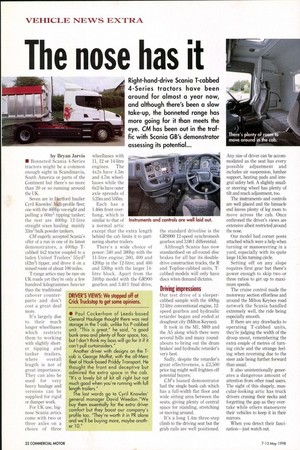The nose has it Right-hand-drive Scania T-cabbed 4-Series tractors have
Page 24

If you've noticed an error in this article please click here to report it so we can fix it.
been around for almost a year now, and although there's been a slow take-up, the bonneted range has more going for it than meets the eye. CM has been out in the traffic with Scania GB's demonstrator assessing its potential...
by Bryan Jarvis • Bonneted Scania 4-Series tractors might be a common enough sight in Scandinavia, South America or parts of the Continent but there's no more than 20 or so running around the UK.
Seven are in ord haulier Cyril Knowles' -profile fleet: one with the 4601p vee-eight and pulling a 60m3 tipping tanker; the rest are 400hp 12-litre straight sixes hauling mainly 33m3 bulk powder tankers.
CM eagerly accepted Scania's offer of a run in one of its latest demonstrators, a 400hp Tcabbed 4x2 tractor coupled to a laden United Trailers' 55yd3 (42m3) tipper, and drove it on a mixed route of about 100 miles.
It's largely due to their much longer wheelbases which restricts them to working with slightly shorter tipping and tanker trailers, where overall length is not of great importance. They can also be used for very heavy haulage and versions can be supplied for rigid or dumper work.
For UK use, bignose Scania artics come with two or three axles on a choice of three wheelbases with 11, 12 or 14-litre engines. The 4x2s have 4.3m and 4.7m wheelbases while the 6x2/4s have outer axle spreads of 5.25m and 5.65m.
Each has a 1.46m front overhang, which is similar to that of a normal artic except that the extra length behind the cab limits it to partnering shorter trailers.
There's a wide choice of power: 340 and 380hp with the 11-litre engine; 360, 400 and 420hp in the 12-litre; and 460 and 530hp with the larger 14litre block. Apart from the 340hp model with the GR900 gearbox and 3.40:1 final drive, the standard driveline is the GRS900 12-speed synchromesh gearbox and 3.08:1 differential.
Although Scania has now standardised on all-round disc brakes for all bar its doubledrive construction trucks, the R and Topline-cabbed units, Tcabbed models will only have discs when demand dictates.
Driving impressions Our test drive of a sleepercabbed sample with the 400hp 12-litre conventional engine, 12speed gearbox and hydraulic retarder began and ended at doughnut city (Milton Keynes).
It took in the Ml, M69 and the A5 along which there were several hills and many roundabouts to bring out the drum brakes' and hydraulic retarder's very best.
Sadly, despite the retarder's great effectiveness, a £3,500 price tag might well frighten off potential buyers.
CM's loaned demonstrator had the single bunk cab which has a full-width flat floor and wide sitting area between the seats, giving plenty of central space for standing, stretching or moving around.
It's a long 1.4m three-step climb to the driving seat but the grab rails are well positioned. Any size of driver can be accommodated as the seat has every possible adjustment and includes air suspension, lumbar support, heating pads and integral safety belt. A slightly smaller steering wheel has plenty of tilt and reach adjustment, too.
The instruments and controls are well placed and the binnacle end leaves plenty of leg room to move across the cab. Once enthroned the driver's views are extensive albeit restricted around the nose.
Our model had corner posts attached which were a help when turning or manoeuvring in a yard, especially with its quite large 14.5m turning circle.
Setting off on any slope requires first gear but there's power enough to skip two or three ratios to get up to maximum speeds.
The cruise control made the motorway section effortless and around the Milton Keynes road network the Scania handled extremely well, the ride being especially smooth.
If there are any drawbacks to operating T-cabbed units, they're judging the width of the droop snout, remembering the extra couple of metres of turning circle and the strange feeling when reversing due to the steer axle being further forward than usual.
It also unintentionally generates a dangerous amount of attention from other road users. The sight of this shapely, muscular-looking artic has truck drivers craning their necks and forgetting the gap as they overtake while others manoeuvre their vehicles to keep it in their mirrors.
When you detect their fascination—just watch out. DRIVER'S VIEWS: We stopped off at Crick Truckstop to get some opinions.
• Paul Cockerham of Leeds-based General Haulage thought there was real storage in the 1-cab, unlike his P-cabbed unit. "This is great," he said, "a good bunk area and plenty of floor space, too, but I don't think my boss will go for it if it can't pull curtainsiders." Another driver with designs on the Tcab is George Moffat, with the all-Merc fleet of Hook-based Priddy Transport. He thought the front end deceptive but admired the extra space in the cab. "It's a lovely bit of kit all right but not much good when you're running with full length trailers." The last words go to Cyril Knowles' general manager David Weedon."We buy them essentially for the extra driver comfort but they boost our company's profile too. "They're worth it in PR alone and we'll be buying more, maybe another 10."
























































































































